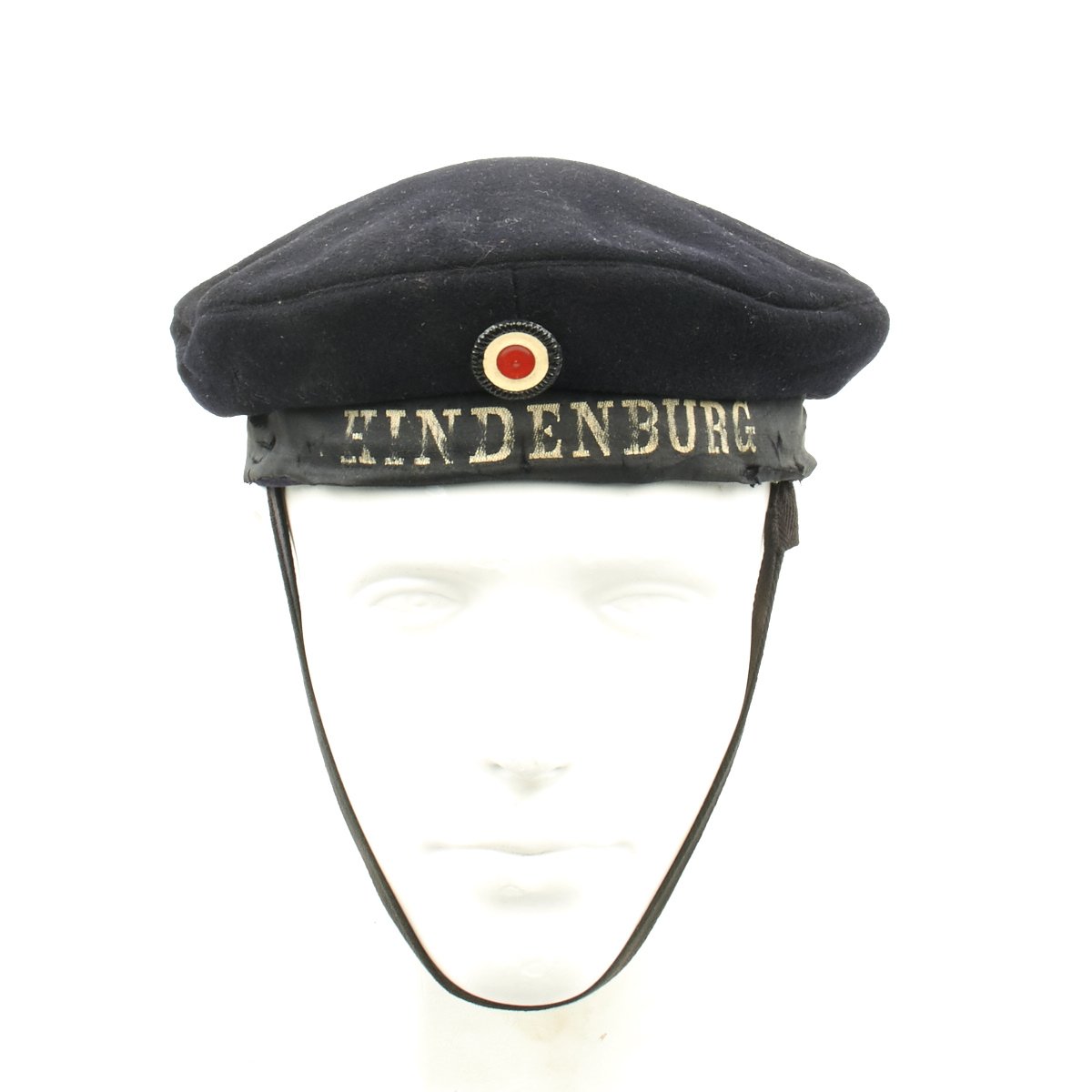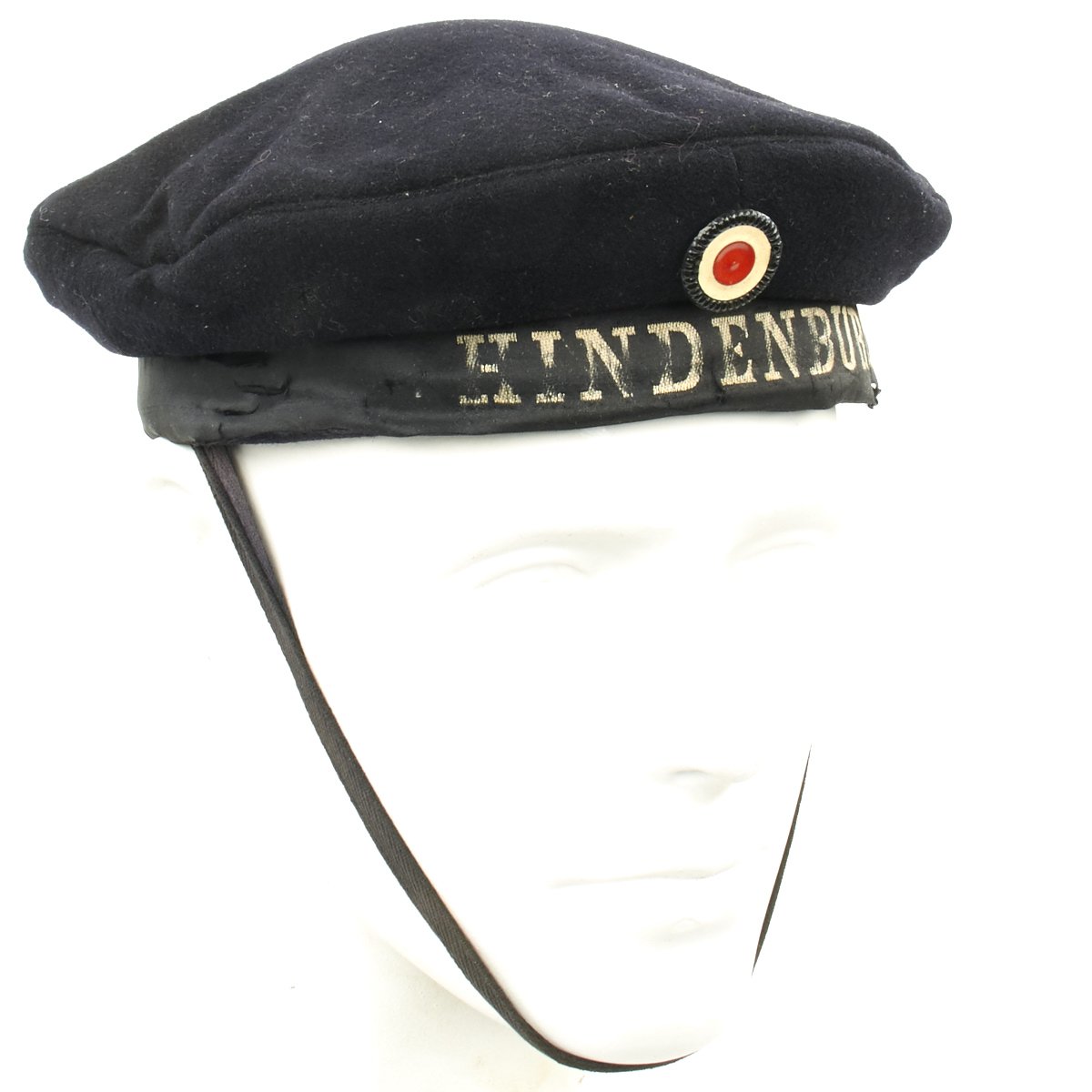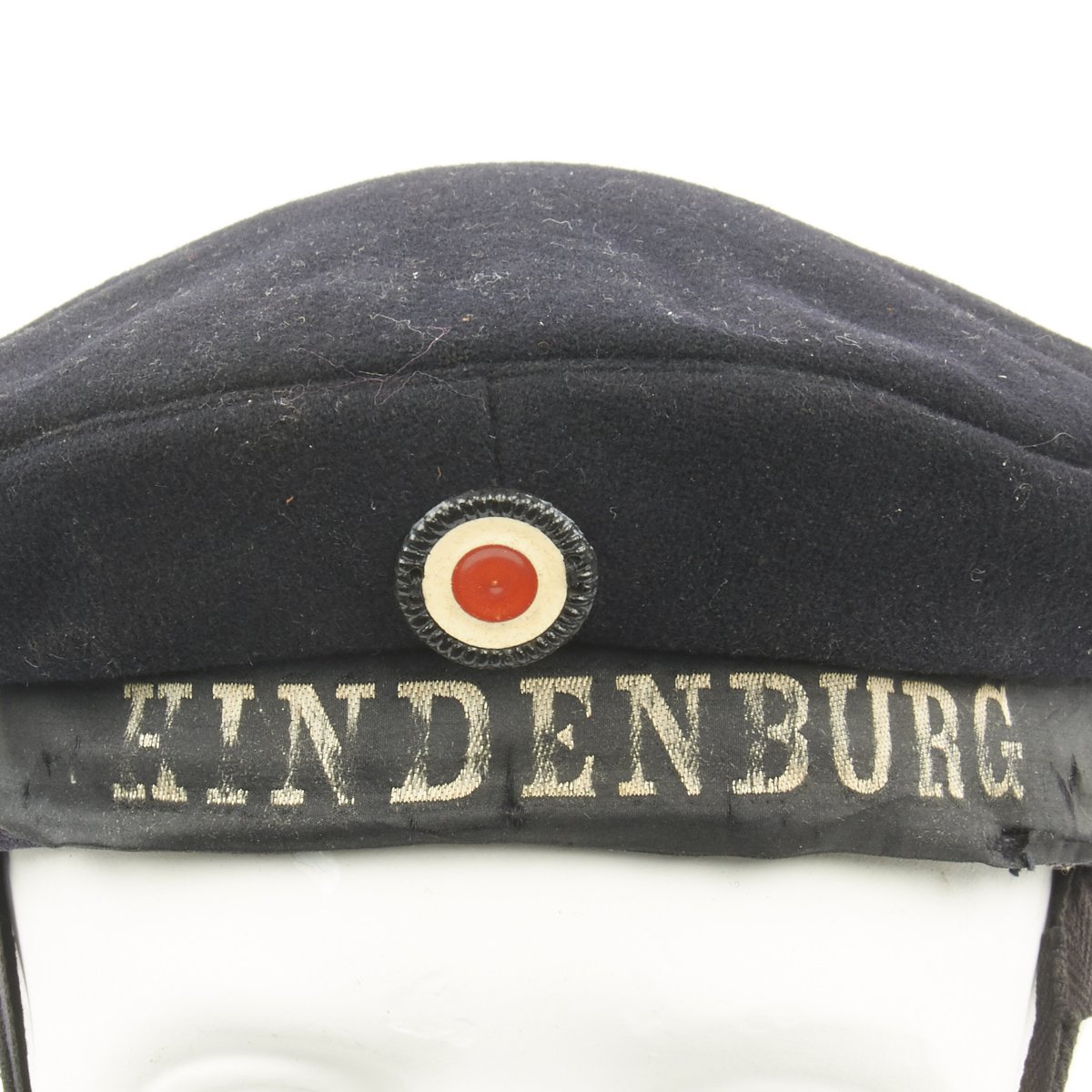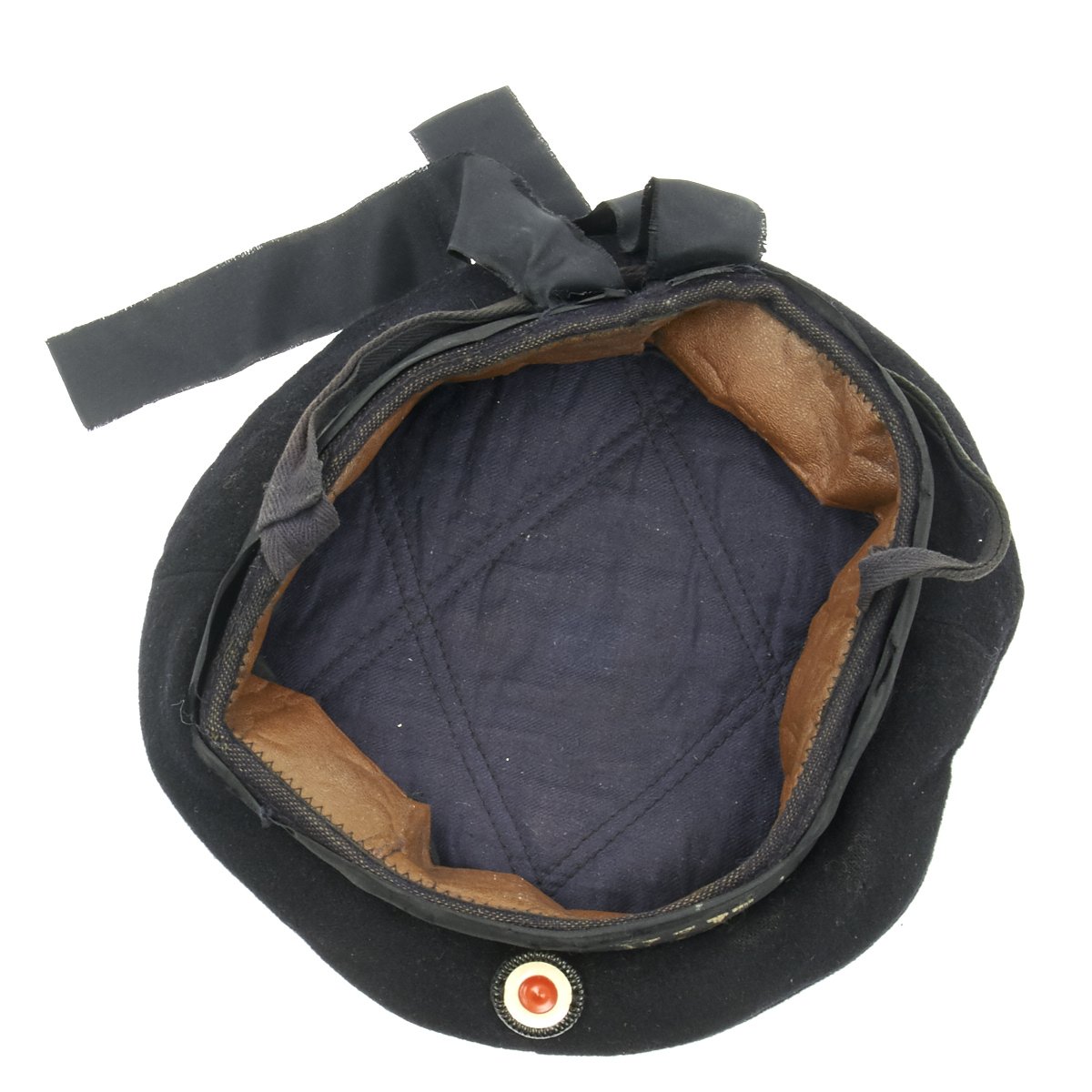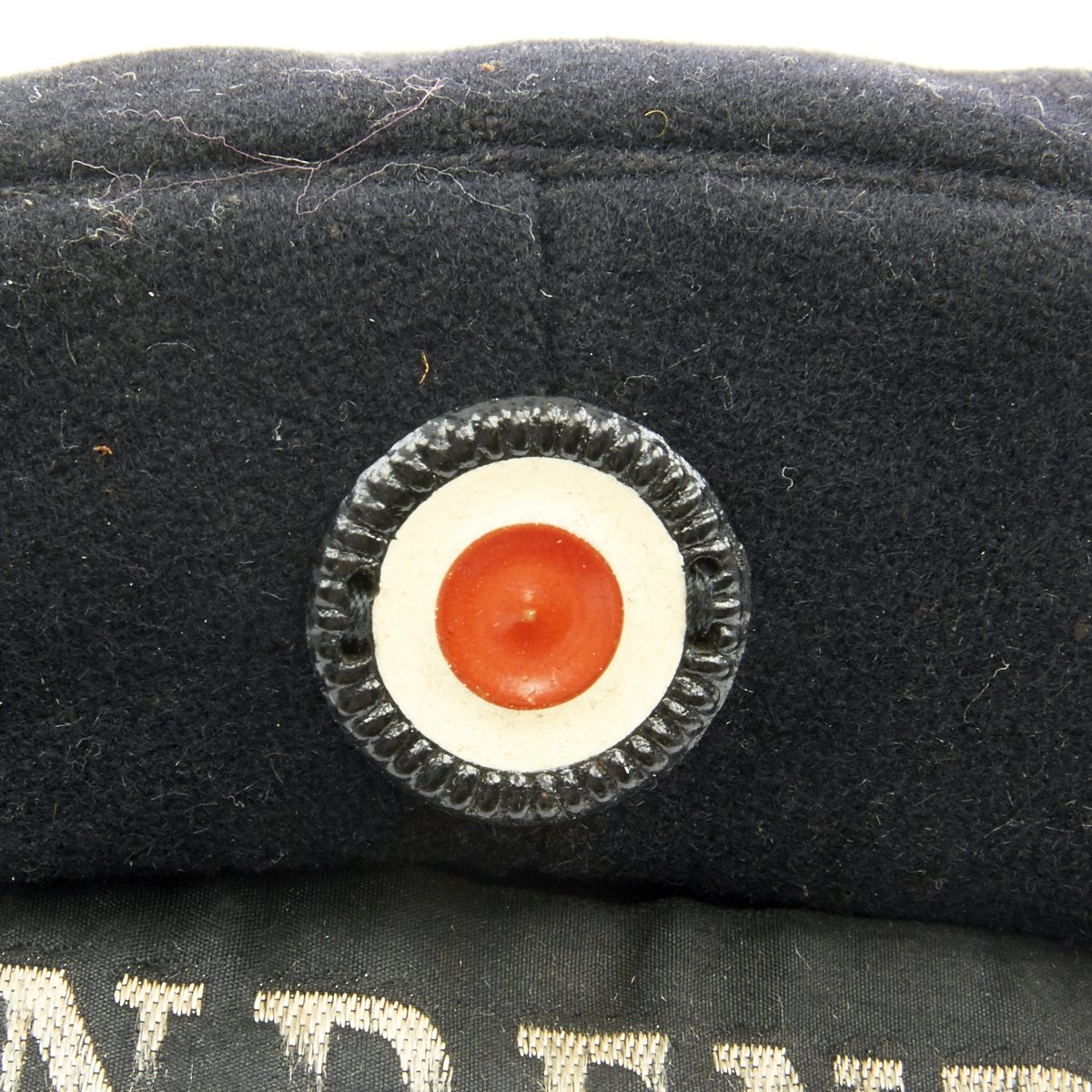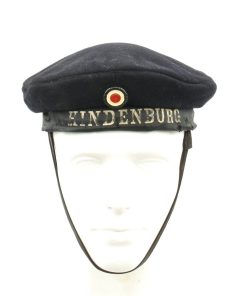Original German WWI SMS Hindenburg Imperial Navy Donald Duck Cap – Tellemutze Original Items
$ 350,00 $ 105,00
Original Item: Only One Available. Good condition genuine WW1 German Kriegsmarine sailors Donald Duck hat. These caps were worn by all Junior NCOs and enlisted men. The cap is in good used condition. The internal crown stiffening wire was removed which was quite common among sailors. The tallies are present. The front reads Hindenburg . The size of the hat is approximate a 54cm (6 3/4).
SMS Hindenburg was a battlecruiser of the German Kaiserliche Marine (Imperial Navy), the third ship of the Derfflinger class, built to a slightly modified design. She carried the same battery of eight 30.5 cm (12.0 in) guns, but in improved turrets that allowed them to fire further. The ship was also slightly larger and faster than her two sister ships. She was named in honor of Field Marshal Paul von Hindenburg, the victor of the Battle of Tannenberg and the Battle of the Masurian Lakes, as well as Supreme Commander of the German armies from 1916. The ship was the last capital ship of any type built for the German navy during World War I.
Hindenburg was commissioned late in the war and as a result had a brief service career. The ship took part in a handful of short fleet operations as the flagship of the I Scouting Group in 1917–18, though saw no major action. The proposed final sortie of the fleet in the last weeks of the war came to nothing when the crews of the capital ships mutinied. Hindenburg was subsequently interned with the rest of the German battlecruisers at Scapa Flow in November 1918. Rear Admiral Ludwig von Reuter ordered the ships be scuttled on 21 June 1919. Hindenburg was the last of the ships to sink. She was raised in 1930 and broken up for scrap over the following two years.
Service history
Built by the Kaiserliche Werft at their shipyard in Wilhelmshaven, Hindenburg was the third and final ship of her class; her sister ships were Derfflinger and Lützow. Designed as a replacement for the elderly protected cruiser Hertha, Hindenburg’s keel was laid down on 30 June 1913. She was launched on 1 August 1915, but due to shifting construction priorities in time of war, she was not completed until 10 May 1917, by which time it was too late for her to see any significant operations in World War I. At the time, British naval intelligence believed the ship was commissioned so late because she had had parts removed to repair Derfflinger after the battle of Jutland in June 1916. In actuality, construction proceeded slowly because of labor shortages.
SMS Hindenburg was the last battlecruiser completed for the Imperial German Navy, and as such had a very short career. She was fully operational by 20 October 1917, but this was too late to see any major operation in World War I. On 17 November Hindenburg and Moltke, along with the light cruisers of the II Scouting Group, were acting as distant support for German minesweepers off the German coast when the minesweepers were attacked by British warships. The British raiders included the new battlecruisers Repulse, Courageous, and Glorious. However, the raid was brief; by the time Hindenburg and Moltke arrived on the scene, the British ships had broken off the attack and withdrawn. On 23 November, Hindenburg replaced Seydlitz as flagship of the I Scouting Group.
Advance of 23 April 1918
In late 1917, light forces of the High Seas Fleet began interdicting British convoys to Norway. On 17 October the light cruisers Brummer and Bremse intercepted one of the convoys, sinking nine of the twelve cargo ships and the two escorting destroyers—Mary Rose and Strongbow—before turning back to Germany. On 12 December, four German destroyers ambushed a second British convoy of five cargo vessels and two British destroyers. All five transports were sunk, as was one of the destroyers. Following these two raids, Admiral David Beatty, the commander of the Grand Fleet, detached battleships from the battle fleet to protect the convoys. The German navy was now presented with an opportunity for which it had been waiting the entire war: a portion of the numerically stronger Grand Fleet was separated and could be isolated and destroyed. Vice Admiral Franz von Hipper planned the operation: the battlecruisers of the I Scouting Group, along with light cruisers and destroyers, would attack one of the large convoys, while the rest of the High Seas Fleet would stand by, ready to attack the British dreadnought battleship squadron.
At 05:00 on 23 April 1918, the German fleet, with Hindenburg in the lead, departed from the Schillig roadstead. Hipper ordered wireless transmissions be kept to a minimum, to prevent British intelligence from receiving radio intercepts. At 06:10 the German battlecruisers had reached a position approximately 60 kilometers southwest of Bergen, when Moltke lost her inner starboard propeller. Without resistance from the water, the propeller-less shaft began spinning faster and faster, until one of the engine gears flew apart. Shrapnel from the broken machinery damaged several boilers and tore a hole in the hull; the ship was dead in the water.[12] The ship’s crew effected temporary repairs, which allowed the ship to steam at 4 knots (7.4 km/h; 4.6 mph). However, it was decided to take the ship under tow by the battleship Oldenburg. Despite this setback, Hipper continued northward. By 14:00, Hipper’s force had crossed the convoy route several times but had found nothing. At 14:10, Hipper turned his ships southward. By 18:37, the German fleet had made it back to the defensive minefields surrounding their bases. It was later discovered that the convoy had left port a day later than expected by the German planning staff.[
Later planned operations
On 11 August 1918, Hipper was promoted to Admiral and given command of the entire High Seas Fleet. Rear Admiral Ludwig von Reuter replaced Hipper as the commander of the I Scouting Group; he raised his flag on Hindenburg the following day.
Hindenburg was to have taken part in what would have amounted to the “death ride” of the High Seas Fleet shortly before the end of World War I. The bulk of the High Seas Fleet was to have sortied from their base in Wilhelmshaven to engage the British Grand Fleet; Admiral Reinhard Scheer intended to inflict as much damage as possible on the British navy, to achieve a better bargaining position for Germany whatever the cost to the fleet.[13] The plan involved two simultaneous attacks by light cruisers and destroyers, one on Flanders and another on shipping in the Thames estuary; Hindenburg and the other four battlecruisers were to support the Thames attack. After both strikes, the fleet was to concentrate off the Dutch coast, where it would meet the Grand Fleet in battle. While the fleet was consolidating in Wilhelmshaven, war-weary sailors began deserting en masse. As Von der Tann and Derfflinger passed through the locks that separated Wilhelmshaven’s inner harbor and roadstead, some 300 men from both ships climbed over the side and disappeared ashore.
On 24 October 1918, the order was given to sail from Wilhelmshaven. Starting on the night of 29 October, sailors on several battleships mutinied; three ships from the III Squadron refused to weigh anchors, and acts of sabotage were committed on board the battleships Thüringen and Helgoland. In the face of open rebellion, the order to sail was rescinded and the planned operation was abandoned. In an attempt to suppress the mutiny, the High Seas Fleet squadrons were dispersed.
Fate
Under the terms of the Armistice between Germany and the Allies that ended World War I, the majority of the German fleet was to be interned at Scapa Flow; this included Hindenburg and the rest of the battlecruisers. On 21 November 1918, the ships to be interned—14 capital ships, seven light cruisers, and 50 of the most modern torpedo boats—departed German waters for what would prove to be the last time. Prior to the departure of the German fleet, Admiral Adolf von Trotha made clear to Rear Admiral Ludwig von Reuter, who was given command of the ships to be interned, that he could not allow the Allies to seize the ships, under any conditions. The fleet rendezvoused with the British light cruiser Cardiff, which led the ships to the Allied fleet that was to escort the Germans to Scapa Flow. The massive flotilla consisted of some 370 British, American, and French warships.
The fleet remained in captivity during the negotiations in Versailles that ultimately produced the treaty that ended the war. A copy of The Times informed von Reuter that the Armistice was to expire at noon on 21 June 1919, the deadline by which Germany was to have signed the peace treaty. Rear Admiral von Reuter came to the conclusion that the British intended to seize the German ships after the Armistice expired. To prevent this, he decided to scuttle his ships at the first opportunity. On the morning of 21 June, the British fleet left Scapa Flow to conduct training maneuvers; at 11:20 Reuter transmitted the order to his ships. Hindenburg was the last ship to sink, at 17:00. Her captain had deliberately arranged that the ship sank on an even keel to make it easier for her crew to escape. After several unsuccessful attempts, she was raised on 23 July 1930, only to be scrapped at Rosyth between 1930 and 1932.
Fast Shipping with Professional Packaging
Thanks to our longstanding association with UPS FedEx DHL, and other major international carriers, we are able to provide a range of shipping options. Our warehouse staff is expertly trained and will wrap your products according to our exact and precise specifications. Prior to shipping, your goods will be thoroughly examined and securely secured. We ship to thousands clients each day across multiple countries. This shows how we're dedicated to be the largest retailer on the internet. Warehouses and distribution centres can be located throughout Europe as well as the USA.
Note: Orders with more than one item will be assigned a processing date depending on the item.
Before shipping before shipping, we'll conduct a thorough inspection of the items you have ordered. Today, the majority of orders will be delivered within 48 hours. The delivery time will be between 3-7 days.
Returns
The stock is dynamic and we cannot completely manage it because multiple stakeholders are involved, including our factory and warehouse. So the actual stock may alter at any time. It's possible that you may not receive your order once the order has been made.
Our policy is valid for a period of 30 days. If you don't receive the product within 30 days, we are not able to issue a refund or an exchange.
You can only return an item if it is unused and in the same state as the day you received it. You must have the item in its original packaging.
Related products
Uncategorized
Uncategorized
Uncategorized
Uncategorized
Uncategorized
Uncategorized
Uncategorized
Uncategorized
Uncategorized
Uncategorized
Uncategorized
Uncategorized
Uncategorized
Uncategorized
Uncategorized
Uncategorized
Band of Brothers ORIGINAL GERMAN WWII Le. F.H. 18 10.5cm ARTILLERY PIECE Original Items
Uncategorized
Armored Burgonet Helmet & Polearm from Scottish Castle Leith Hall Circa 1700 Original Items
